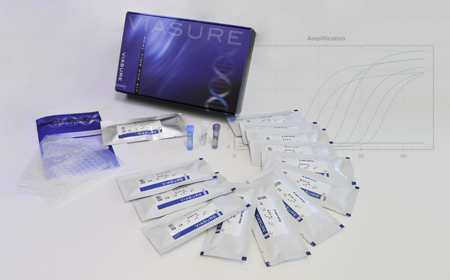
VIASURE Real Time PCR Detection Kits
E. coli EHEC, EPEC & EIEC

Description
VIASURE E. coli EHEC + EPEC + EIEC Real Time PCR Detection Kit is designed for the specific identification and differentiation of Enterohemorrhagic Escherichia coli (EHEC), Shiga toxin-producing Escherichia coli (STEC), Enteropathogenic Escherichia coli (EPEC) and Enteroinvasive Escherichia coli (EIEC)/Shigella in human stool samples from patients with signs and symptoms of gastrointestinal infection.
This test is intended to be used as an aid in the diagnosis of EHEC, STEC, EPEC and EIEC/Shigella in combination with clinical and epidemiological risk factors.
DNA is extracted from stool specimens, multiplied using Real Time amplification and detected using specific primers and a fluorescent reporter dye probe for EHEC, STEC, EPEC and EIEC/Shigella.
Specifications
Information
Escherichia coli is (E. coli) a gram-negative microorganism that can be an innocuous resident of the gastrointestinal tract, but it also has the pathogenic capacity to cause enteric disease, and extraintestinal diseases, as urinary tract infections (UTIs) and sepsis/meningitis. Pathogenic variants of E. coli (pathovars or pathotypes) cause much morbidity and mortality worldwide, due to they have low infectious doses and are transmitted through ubiquitous mediums, including food and water. Of the strains that cause diarrhoeal diseases, six pathotypes are now recognized: Enterohaemorrhagic E. coli (EHEC), Enterotoxigenic E. coli (ETEC), Enteroinvasive E. coli (EIEC), Enteropathogenic E. coli (EPEC), Enteroaggregative E. coli (EAggEC), and Diffusely adherent E. coli (DAEC). Furthermore, different E. coli strains may belong to more than one pathotype group owing to the expression of different virulence factors.
Enterohaemorrhagic E. coli (EHEC) is a subset of Shiga toxin-producing E. coli (STEC), also called verotoxinproducing E. coli. STEC are a diverse group of food-borne pathogens which cause a wide spectrum of human diseases, ranging from mild diarrhoea to severe human diseases, including hemorrhagic colitis (HC) and a lifethreatening complication hemolytic uremic syndrome (HUS). Their virulence is related in part to their capacity to produce Stx1 and/or Stx2, potent cytotoxins that inhibit host cell protein synthesis. In addition, typical EHEC are often characterised by the production of an outer membrane protein called intimin, whis is enconded by the eae gene. This protein mediates both tight attachment of bacteria to enterocytes, as well as lesions (both attaching and effacing (A/E lesions)) in the colon. STEC and EHEC strains can be transmitted to humans through person-toperson contact; consumption of raw or undercooked meat, raw milk and other dairy products; ingestion of other food or drinking water contaminated with animal faeces; direct contact with domestic cattle and other ruminants recognised as a major reservoir, and contaminated bathing/ recreational water. The more clinically relevant STEC strains belong to the serotype O157:H7, followed by O26:H11, O103:H2, O111:H8, and O145:H28.
Enteropathogenic E. coli (EPEC) also contains eae as EHEC, but without shiga-like toxin. EPEC adhere to small bowel enterocytes, and destroy the normal microvillar architecture, inducing the characteristic attaching and effacing lesion. EPEC is an important cause of potentially fatal infant diarrhoea in developing countries that is often accompanied by fever, vomiting, and dehydration in children under 2 years of age. It is transmitted via the fecal-oral route through contaminated surfaces, weaning fluids, and human carriers.
Enteroinvasive E. coli (EIEC) are biochemically, genetically and pathogenically closely related to Shigella spp. Both bacteria express the invasion plasmid antigen H (ipaH) gene which is related to invasion. There are four Shigella species responsible for human disease (S. dysenteriae, S. flexneri, S. sonnei and S. boydii), which cause varying degrees of dysentery. This infection is characterized by fever, abdominal cramps and diarrhoea containing blood and mucous. Severe shigellosis complications are often associated with the Shiga toxinproducing serotype S. dysenteriae 1 and can range from local intestinal disorders to systemic manifestations. Instead, EIEC might cause an invasive inflammatory colitis, and occasionally dysentery, but in most cases EIEC elicits watery diarrhoea that is indistinguishable from that due to infection by other E. coli pathogens. Conventional transmission of EIEC and Shigella is mediated via the fecal-oral route mainly through contaminated food or water or direct person-to person spread.
The adoption of molecular techniques has allowed for more rapid detection and identification of the different E. coli pathotypes. Thus, it provides the critical information for determining appropriate therapies for patients with suspected E.coli infections and controlling of the outbreak.

